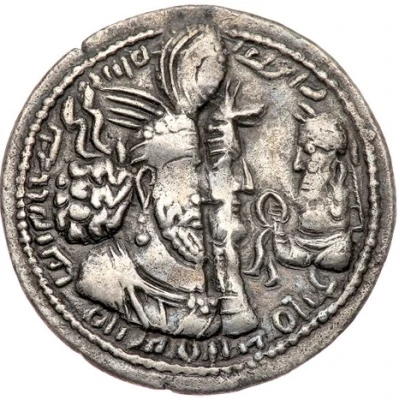


Hemidrachm - Varhran II
| Silver (.900) | 1.73 g | - |
| Issuer | Sasanian Empire (Sasanian Empire (224-651)) |
|---|---|
| Emperor | Bahram II (274-293) |
| Type | Standard circulation coin |
| Years | 276-293 |
| Value | Hemidrachm (1⁄24) |
| Currency | Dinar (224 AD-651 AD) |
| Composition | Silver (.900) |
| Weight | 1.73 g |
| Shape | Round (irregular) |
| Technique | Hammered |
| Orientation | Coin alignment ↑↓ |
| Demonetized | Yes |
| Updated | 2024-10-10 |
| Numista | N#60904 |
|---|---|
| Rarity index | 100% |
Reverse
Along the sides of the atasdan are two figures facing the altar. The attendant on the right is a figure of Anahita in a kulah crowend by the head of a bird or winged crown, with the "wreath of power" in his hand. The figure on the left wears the crown of Varhran II and raises his hand (laurel wreath).
Bull-symbol over the flames.
Edge
Plain
Comment
Göbl# VII/2: Two attendants wearing a winged crowns surmounted by globes.Göbl# VII/2a: The attendant on left wearing a winged crown, the other on right a mural crown surmounted by globe.
Göbl# VII/1a: The attendant on left wearing a mural crown surmounted by globe, the other on right a winged crown. Wreath symbol over the flames
Göbl# VII/1: The attendant on left wearing a winged crown, the other on right a mural crown surmounted by globe. Bull symbol over the flames
Interesting fact
One interesting fact about the Hemidrachm - Varhran II (276-293) coin from the Sasanian Empire is that it features a unique blend of Iranian and Roman influences in its design. The coin's obverse side bears the image of King Varhran II, while the reverse side features a representation of the goddess Anahita, who was revered in ancient Iran as a symbol of fertility and prosperity. This blending of cultural influences reflects the complex history of the Sasanian Empire, which was situated at the crossroads of the ancient world and was shaped by a variety of cultural and religious traditions.



